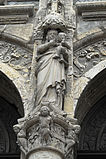Notre-Dame (Saint-Calais)
The Catholic parish church of Notre-Dame in Saint-Calais , a municipality in the Sarthe department in the French region of Pays de la Loire , was opened in the 15th and 16th centuries. Erected in the 13th century on the site of a previous building from the early 13th century. The church, whose architectural style mixes the forms of the Flamboyant Gothic and the Renaissance , has a magnificent west portal from the 16th century and inside numerous stained glass windows from the 19th century. In the church, the so-called shroud of Saint Carilefus ( Calais ) is venerated as a relic , who founded the Anisole Abbey on the bank of the Anille in the 6th century and after whom the place is named. As early as 1840, the church was included in the list of architectural monuments in France as Monument historique .
history
In 1425, construction began on the current church, which was to replace a modest wooden church. The originally single-nave nave was enlarged in 1520 by adding a three-bay aisle on the north side. Another aisle was later added on the south side.
architecture
Bell tower
At the eastern end of the south aisle rises the 58 meter high bell tower, the foundation walls of which date back to the 12th century. The tower, which is crowned by a stone, octagonal pointed helmet, was completed between 1619 and 1623.
West facade
The west facade was designed in the Renaissance style in the 16th century. It has three portals and is framed by lantern-like attachments decorated with figures.
A four-lane window with a basket arch opens above the main portal , above you can see a bust of Christ embedded in a triangular gable. Under the roof approach, Moses is depicted with the tablets of the law, underneath a small rosette is cut, above which the year 1760 is attached and which serves as a clock.
The main portal, a double arched portal, was created between 1520 and 1550. It is framed by pilasters and carved wood doors depicting scenes from the life of Mary . On the left side the marriage of Mary with Joseph and the Annunciation are shown, on the right side the Visitation and the Assumption of Mary. The carvings are attributed to the sculptor Guillaume Le Houx, whose initials MGLH can be seen under the right bezel . A Madonna and Child stands on the Trumea pillar . The two side portals are also framed by pilasters with capitals , decorative gables and figure niches under canopies .
inner space
The nave has three aisles and extends over five bays . In the east it opens into a two-bay, straight closed choir , the east wall of which is pierced by an ogival, four-lane tracery window.
Leaded glass window
The leaded glass windows date from the late 19th and early 20th centuries. Some of the windows bear the signature of the glass painter Hucher and the glass painting workshop of the Carmelites of Le Mans . The window depicting Louis-Ernest Dubois , Cardinal and Archbishop of Paris , bears the signature of Henri-Marcel Magne . In addition to the Cardinal is his patron saint , the French king Saint Louis , his coat of arms is displayed in the tracery.
Shroud of St. Carilefus
Two pieces of an embroidered silk fabric from the 6th / 7th centuries are in the church. Century of Sasanid or Byzantine origin, which are venerated as the shroud of St. Carilefus. The monks of Anisole Abbey are said to have brought the remains of their monastery founder to safety in Blois when they fled their monastery from the Normans around 837 . There they were later housed in the Saint-Calais chapel of the Castle of Blois until they were returned to Saint-Calais in the 17th and 18th centuries. Today the bones of the saint are kept in a neo-Gothic reliquary from the 19th century.
Choir stalls
The choir stalls date from the 16th century.
organ
The organ front was created between 1660 and 1670 and comes from the former abbey church of Saint-Calais. It was declared a monument historique in 1871 . The instrumental part of the organ was manufactured in 1845 by the organ building company Daublaine et Callinet and classified as a Monument historique in 1973 .
Web links
- Église Notre-Dame in the Base Mérimée of the French Ministry of Culture (French)
- Gallery organ in the Base Palissy of the French Ministry of Culture (French)
- L'Église Notre Dame Mairie de Saint-Calais (accessed February 28, 2016, in French)
- Le suaire de Saint-Calais; Les orgues de Saint-Calais Communauté de communes du Pays Calaisien (accessed February 28, 2016, in French)
- Église Notre-Dame musiqueorguequebec.ca (accessed on February 28, 2016, English and French)
Individual evidence
- ↑ Saint Carilephus, first abbot of Anille, in the Maine province heiligenlegend.de (accessed on February 28, 2016)
- ↑ Vitraux du XIXème siècle de Saint-Calais ( Memento of the original of February 28, 2016 in the Internet Archive ) Info: The archive link was inserted automatically and has not yet been checked. Please check the original and archive link according to the instructions and then remove this notice. Communauté de communes du Pays Calaisien (accessed February 28, 2016, French)
- ↑ Sudarium (suaire) de saint Calais in the Base Palissy of the French Ministry of Culture (French)
- ↑ Joachim Schäfer: Carilefus von Le Mans Ecumenical Lexicon of Saints (accessed on February 28, 2016)
- ↑ Choir stalls in the Base Palissy of the French Ministry of Culture (French)
- ^ Organ, gallery and prospectus in the Base Palissy of the French Ministry of Culture (French)
- ^ Organ, instrumental part in the Base Palissy of the French Ministry of Culture (French)
Coordinates: 47 ° 55 ′ 17 ″ N , 0 ° 44 ′ 45 ″ E












